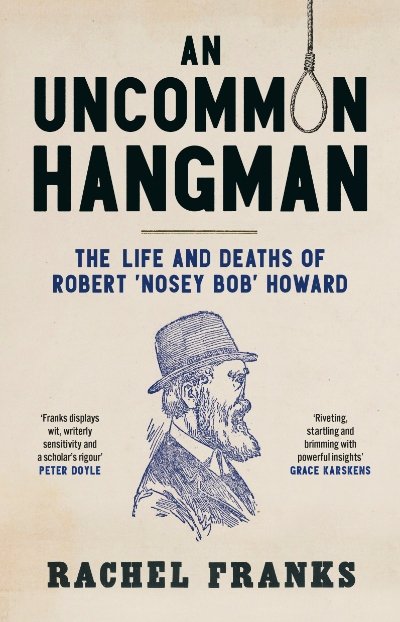An uncommon hangman, the life and deaths of Robert ‘Nosey Bob’ Howard
Crime and punishment: the irresistible twin themes for novelists and film makers, as well as lawmakers and historians. Rachel Franks brings to the story of hangman Nosey Bob Howard the craft of both crime fiction and history, revealing stories of the executioner and his ‘patients’. Her approach raises questions for professional historians about how to write compelling narrative history.
READ REVIEW
↓
An uncommon hangman, the life and deaths of Robert ‘Nosey Bob’ Howard
Rachel Franks | 2022
‘Nosey Bob’ Howard lost his nose in an altercation with a horse, or so he maintained. Rachel Franks is not so sure, and by the end of the book nor is the reader. Here is the first question for the historian: how far can we speculate when the record is vague or incomplete?
With this disfigurement, Howard could not continue being a cab driver. Instead, he became a hangman, working for the NSW Sheriff for 26 years from 1876 to 1904, and lawfully killing 61 men and one woman. Of those, 46 were ‘clean’ hangings; the others were botched, resulting in decapitation or, even worse, slow strangulation. Franks details every one of these executions. Over and over, we read about the rope, the length of the drop. Often, we know what the condemned person ate, how much they weighed, who else was on the scaffold. Important details to recount in the life of a hangman, but it gets tedious.
Franks relates what she has found in the court records and newspaper accounts of each criminal – this is a story of 62 deaths, as well as one life. The book offers a glimpse into the underbelly of colonial life: murder, robbery, rape. Most horrifying for me was to learn of the baby farmers – people who took in unwanted children for a fee, usually a lump sum and a weekly amount thereafter. Many of these babies died from neglect or incompetent care. Some were murdered.
We also meet an array of ethnicities: Anglo Saxons, Europeans, Chinese, First Nations peoples. These are fleeting encounters, gleaned from reports of their crimes and punishment. After a while, I started to ask if some of these stories might deserve a more complete telling, which could shed light on the times they lived in. Here is a second question, one of the hardest for a conscientious researcher like Franks: what do we leave out?
Howard was not, as executioners are often portrayed, a monster. Franks’ account reveals him to be a rather ordinary bloke: husband, father, grandfather, gardener, fisherman. Because she often mentions a fact about a wedding or a birth at the end of a section, like the ending of an episode in a drama series, I kept expecting to learn more. But these are not clues in a crime novel; nothing comes of these observations. Instead, they are attempts to round out Howard’s life, something Franks also tries to do by suggesting what Howard might have felt. My final questions are tricky ones: how far can the historian use novelistic devices? Why not introduce some suspense to keep the reader engaged? How much should the historian extrapolate from the record?
Fascination with the hangman’s trade notwithstanding, Franks is opposed to the death penalty. She covers the debates against judicial murder that prevailed before, during and after Howard’s term. While the death penalty finally disappeared from the NSW statute books in 1985 (yes, only then), it remains part of the legal system in many countries. China is on top of this grim leader board. It is secretive about what probably amounts to thousands of prisoners killed every year. We do know the numbers for the United States: so far in 2022, seven people have been executed in five US states.
In her final remarks, Franks suggests that Howard’s story ‘tells us much about the story of Australia, about who we are and who we wanted to be’. If we want to be a more humane society, we need to keep campaigning against the death penalty worldwide, not just when an Australian citizen finds themselves on death row.
An uncommon hangman, the life and deaths of Robert ‘Nosey Bob’ Howard is published by New South.
Reviewer: Francesca Beddie, PHA (NSW & ACT)

